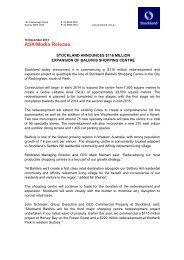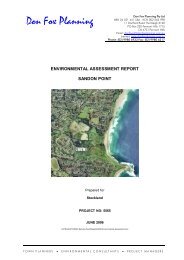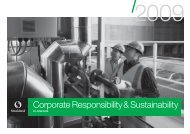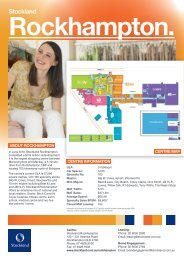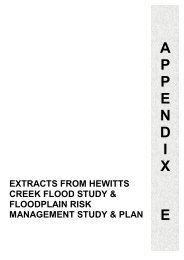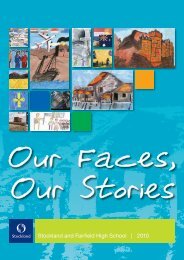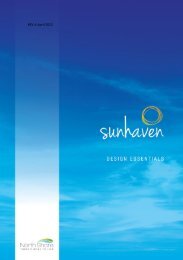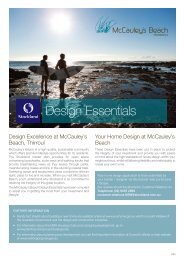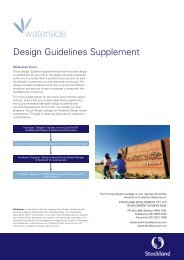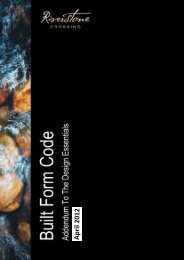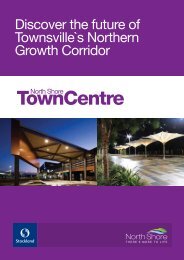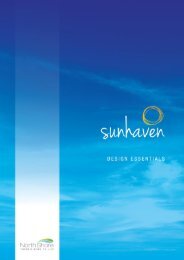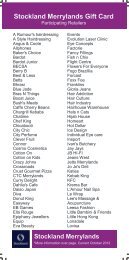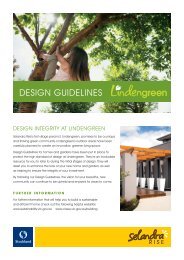Download PDF - Stockland
Download PDF - Stockland
Download PDF - Stockland
Create successful ePaper yourself
Turn your PDF publications into a flip-book with our unique Google optimized e-Paper software.
• Checks of the balance and accuracy of sampled qualitative performance information<br />
(such as performance claims), through interviews and document review;<br />
• Visits to <strong>Stockland</strong>’s headquarters in Sydney, New South Wales and eight <strong>Stockland</strong><br />
sites: Balgowlah and Merrylands, New South Wales, North Lakes and Waterfront Place,<br />
Queensland, Gowanbrae and Highlands, Victoria, 2 Victoria Avenue and Settlers Hills/<br />
Baldivis, Western Australia;<br />
• An independent check of <strong>Stockland</strong>’s material issues and stakeholder views on<br />
these issues, including analysis of peer reports, media articles on <strong>Stockland</strong> in FY10,<br />
<strong>Stockland</strong>’s own documentation and engagement records and issues identified from<br />
Banarra’s interviews;<br />
• A review of the Report to check that it appropriately communicates the nature<br />
and extent of <strong>Stockland</strong>’s adherence to the AA1000APS Principles; and<br />
• A review of the Report to check consistency with the GRI application level requirements.<br />
Findings and Recommendations<br />
Banarra’s findings and recommendations in relation to <strong>Stockland</strong>’s adherence to the<br />
AA1000APS Principles, the reliability of the reported performance information and<br />
adherence to the GRI requirements are provided below.<br />
Assurance Opinion: AA1000APS Principles<br />
We believe <strong>Stockland</strong> has appropriately communicated the nature and extent of its<br />
adherence to the AA1000APS Principles in the Report.<br />
Inclusivity – has <strong>Stockland</strong> engaged with its stakeholders?<br />
<strong>Stockland</strong>’s CR&S Strategy commits the organisation to being responsive to the interests<br />
of stakeholders and key stakeholder issues are escalated to Board level. Employees across<br />
the organisation are comfortable identifying their stakeholders and the importance of upfront<br />
engagement is widely acknowledged. Stakeholder Engagement Plans are now in place<br />
across all projects, including Retirement Living, and these have been updated to include<br />
conflicting issues between stakeholder groups as per our recommendation from last year.<br />
Banarra identified the following areas for improvement:<br />
• Stakeholder Engagement Plans are seen primarily as documenting current engagement<br />
approaches, especially on existing projects – they could do more to drive improvements<br />
in practice;<br />
• We are not aware of any formal mechanisms for assessing and building the capacity of<br />
stakeholders with additional needs to engage with <strong>Stockland</strong> – doing this would ensure<br />
all key stakeholder groups are heard; and<br />
• Retirement Living measures its residents’ satisfaction on an annual basis – the<br />
Residential and Commercial business units could also implement longer term customer<br />
satisfaction mechanisms, something which we note Residential plans to progress<br />
in FY11.<br />
Materiality – has <strong>Stockland</strong> identified its most important sustainability issues?<br />
The CR&S team and business units have a comprehensive process for identifying<br />
<strong>Stockland</strong>’s material issues, which now includes a broader range of internal and external<br />
stakeholder views. <strong>Stockland</strong>’s materiality process identified 14 overarching issues for 2010.<br />
Banarra’s process found evidence to support the materiality of the majority of these issues.<br />
Our testing also identified a further four additional issues as being material: responsible<br />
design & development, corporate strategy & growth, employee remuneration and<br />
leadership. <strong>Stockland</strong> has acknowledged all these issues in the Report, with the exception<br />
of the impact of leadership changes during the reporting year.<br />
The CR&S team has engaged with the risk and strategy teams to identify material issues<br />
and there are plans for a joint workshop next year. We believe <strong>Stockland</strong> should take this<br />
further and formally incorporate the materiality process into business planning across<br />
the organisation.<br />
Banarra identified the following areas for improvement:<br />
• In FY10 <strong>Stockland</strong> focused its understanding and strategic response to climate<br />
change risks and opportunities on the immediate physical risks of climate change for<br />
Residential – it would be beneficial to assess a fuller scope of risks and opportunities<br />
across all areas of the business and engage with customers and partners on this<br />
issue; and<br />
• The Report contains numerous performance indicators, however in some cases<br />
there is minimal or no commentary discussing the results (such as women in<br />
leadership positions and in Residential management) – data analysis could be<br />
applied more consistently so that <strong>Stockland</strong> is in a stronger position to communicate<br />
its understanding in the Report.<br />
Responsiveness – has <strong>Stockland</strong> responded to these issues?<br />
There is general agreement that CR&S is well resourced in <strong>Stockland</strong>. <strong>Stockland</strong> has<br />
responses relating to all of its material issues and the corporate CR&S Strategy is now<br />
supported by Business Unit CR&S strategies along with those from other parts of the<br />
business, such as Human Resources. At the site level there is now greater awareness of the<br />
corporate CR&S strategies, policies and tools.<br />
Banarra found only limited involvement of stakeholders in developing responses and as<br />
such our recommendation from last year to better integrate stakeholder feedback into<br />
decision-making stands. We also recommended that <strong>Stockland</strong> ensures its accounting<br />
for performance is clear and concise and that there are quantifiable targets for all material<br />
issues, however many of the future commitments in the Report are given in broad terms,<br />
making it challenging for stakeholders to assess the response and the progress made.<br />
<strong>Stockland</strong> has again voluntarily piloted the Property Council of Australia’s draft Guide to<br />
Corporate Responsibility Reporting in the Property Sector and we are pleased that it has<br />
responded to our recommendation last year to start to report on land with high biodiversity<br />
value lost to development. There are opportunities for Residential and Retirement Living to<br />
develop more meaningful and comparable environmental metrics in other areas, such as<br />
energy and water efficiency. There are also opportunities for reporting on sustainable supply<br />
chain management performance.<br />
<strong>Stockland</strong> Corporate Responsibility & Sustainability Report June 2010<br />
106



